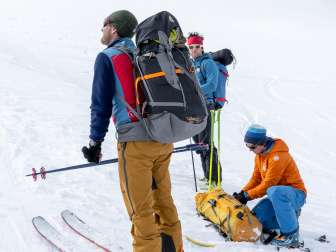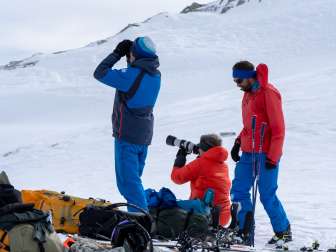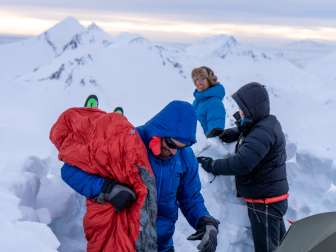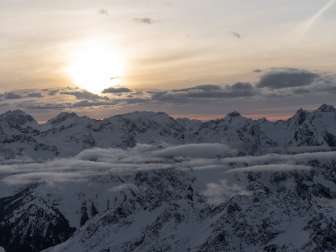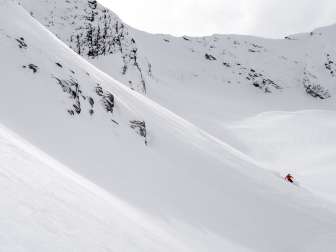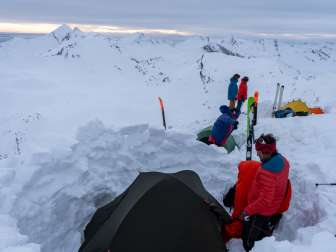Out and about with the mountain guides from the Grischa mountain sports school and photographer Cyrill Bühler. In search of a new, impressive tour route for the next winter season and on the trail of the old routes that once connected the Avers with the south, but have been somewhat forgotten.
From Lars Dünner
The weather forecast is good and the avalanche situation in the region has calmed down again in the last few days. I take the Postbus to Juf in the Avers, where I meet up with the four mountain guides and the photographer. After the final detailed planning on site, we set off and walk through the wonderful Jufer valley towards the ascent. The feeling of being away from civilization already sets in here. As we pass the Jufer-Alp, I start to feel the weight of my large rucksack, packed full for the two-day tour, with a bivouac for the overnight stay, and hope that I haven't packed too much unnecessary ballast as usual. I imagine how goods were transported along the trade routes to the south and vice versa in the early days of the settlers. In those days, the Avers was heavily dependent on the connections over the Septimer and Prasgnola Passes. Unimaginable feats that were accomplished at that time.

The sun keeps pushing through the foehn haze and we soon catch sight of Piz Piot at 3053 m above sea level on the horizon, which forms the far end of the Avers valley. After a steeper ascent, we reach the wide area below the Jufer Joch, where the Piot glacier once lay. A scene straight out of a picture book. The mountain guide Stiwi sprints up towards the top of the mountain on his skis and then skis down a steep mountain flank for the perfect photo. I am impressed by the professionalism and fitness of the team from the Grischa mountain sports school and quickly realize that my fitness level as a recreational mountaineer is miles away.
After this stopover, we head up to the yoke and continue along the ridge to the summit. The panoramic view from Piz Piot is magnificent. The weather even allows us to see the peaks of the "Monterosa massif" and the granite peaks of Bergell look imposing. We are now standing on the watershed, where the raindrops finally decide to flow south into the Adriatic or north into the Atlantic.
However, resting will have to wait. On the summit, we first have to set up our bivouac camp. After about an hour of shoveling, pitching and setting up, the tents are on level ground, protected from the wind, and everything is in place so that we can devote ourselves to a well-earned dinner. Hunter's stew, cream soup or bouillon soup - everyone has their own culinary delicacy from the instant pack.

The sky slowly turns a soft red and the evening atmosphere amazes us. We skillfully try to capture the beautiful moments with the camera... but it's simply best in real life. Soon the warmth of the sun has disappeared and the time has come to make ourselves comfortable in the tent. The night is surprisingly pleasant, with only the occasional flurry of snow when a gust of wind dislodges the ice crystals from the inside wall of the tent.

We are rewarded in the morning; this is exactly how we imagined it would be. Light wafts of mist lie in the valleys to the south, the sun tickles the first clouds and soon countless colors play together. What could be more beautiful in the world than sunrises on a mountain peak?

But now the focus is elsewhere again. We have to leave the southern valley by eleven o'clock at the latest to avoid the risk of wet snow avalanches. We quickly dismantle everything, pack up and then we're off again. Still heavily laden, we head over steep flanks into Val Maroz, which flows into Bergell. Once we reach the bottom of the valley, the route continues flat. A change to skins is therefore unavoidable in some places.

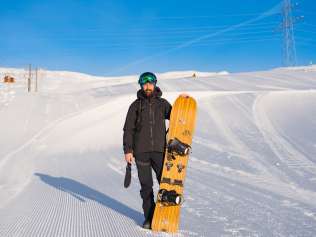
Lars Dünner
Lars - former marketing manager of Viamala Tourism - can often be found in nature in his free time. Preferably away from the hiking trails and always on the lookout for the most beautiful places the region has to offer. As a passionate fly fisherman, mountain hiker and outdoor enthusiast, he knows the Viamala almost better than the back of his hand.
Grischa Mountain Sports School
The Grischa mountain sports school takes you to the most beautiful places in Graubünden.



